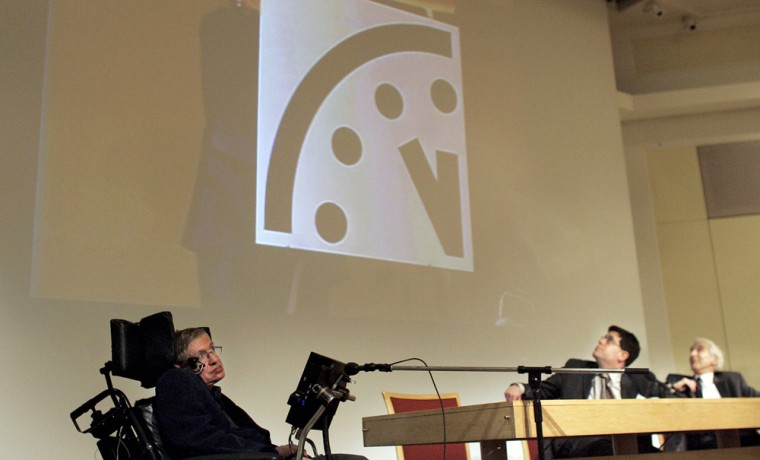The caretakers of the well-known Doomsday Clock on Wednesday moved its symbolic hands two minutes closer to midnight — citing nuclear proliferation and, for the first time, global warming.
It was the fourth time since the end of the Cold War that the clock has ticked forward, this time from 11:53 to 11:55, amid fears over what scientists are describing as “a second nuclear age” prompted largely by atomic standoffs with Iran and North Korea.
The clock's sponsor, The Bulletin of the Atomic Scientists, added that the “dangers posed by climate change are nearly as dire as those posed by nuclear weapons.”
Founded in 1945 as a newsletter distributed among nuclear physicists concerned by the possibility of nuclear war, the group has since grown into an organization focused more generally on manmade threats to the survival of human civilization.
Stephen Hawking weighs in
“As scientists, we understand the dangers of nuclear weapons and their devastating effects, and we are learning how human activities and technologies are affecting climate systems in ways that may forever change life on Earth,” said BAS member Stephen Hawking, the renowned cosmologist and mathematician.
“As citizens of the world, we have a duty to alert the public to the unnecessary risks that we live with every day, and to the perils we foresee if governments and societies do not take action now to render nuclear weapons obsolete and to prevent further climate change.”
The bulletin’s clock, which for 60 years has followed the rise and fall of nuclear tensions, would now also measure climate change, the bulletin’s editor Mark Strauss told The Associated Press.
“There’s a realization that we are changing our climate for the worse,” he said, “That would have catastrophic effects. Although the threat is not as dire as that of nuclear weapons right now, in the long term we are looking at a serious threat.”
The threat of nuclear war, however, remains by far the organization’s most pressing concern. “It’s important to emphasize 50 of today’s nuclear weapons could kill 200 million people,” he said.
18th move of the hand
The decisions to move the clock is made by the bulletin’s board, which is composed of prominent scientists and policy experts, in coordination with the group’s sponsors.
Since it was set to seven minutes to midnight in 1947, the hand has been moved 18 times, including Wednesday’s move.
It came closest to midnight — just two minutes away — in 1953, following the successful test of a hydrogen bomb by the United States. It has been as far away as 17 minutes, set there in 1991 following the demise of the Soviet Union.
